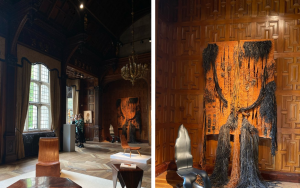A Look into Cross-Collecting and Fair Curatorial Culture at Eye of the Collector 2023

The 2023 edition of Eye of the Collector took place from May 17th to May 20th, captivating art and design enthusiasts with its unique showcase held at Two Temple Place. This year marked the third installment of the fair, a testament to its enduring success and vision, under the guidance of London-based art advisor Nazy Vassegh. Eye of the Collector 2023 stood out by placing a significant emphasis on international Modern and Contemporary artists and designers. In addition to the physical fair, this cultural extravaganza extended its reach through an Artsy online viewing room, a vibrant social platform, and a global collector network, cementing its status as a pivotal event in the art world.
Eye of the Collector is more than just an art fair; it is a convergence of diverse artistic expressions. Unlike conventional art exhibitions, where art and design are often kept separate, Eye of the Collector boldly blurs these boundaries. By presenting works of art and design side-by-side, the fair encourages visitors to explore the interplay between these two creative realms. This cross-collecting approach not only enriches the visitor’s experience but also promotes a broader appreciation for the synergy between art and design.
The fair’s founder and curator, Nazy Vassegh, has been instrumental in shaping its unique identity. With a keen eye for innovation and a deep understanding of the art world, Vassegh has consistently pushed the boundaries of what an art fair can be. Her dedication to promoting emerging and established artists and designers from around the globe has ensured that Eye of the Collector remains a dynamic and forward-thinking event.
One of the standout features of Eye of the Collector 2023 was its focus on international Modern and Contemporary artists and designers. This thematic choice brought together a remarkable array of works that spanned diverse genres, styles, and mediums. It provided a platform for both emerging talents and established luminaries to showcase their creations, fostering a dynamic and inclusive dialogue within the art world.
In an increasingly interconnected world, Eye of the Collector recognized the importance of reaching a global audience. To this end, the fair embraced technology by offering an Artsy online viewing room. This virtual space allowed art enthusiasts from around the world to explore the curated selection of artworks and designs, transcending geographical boundaries and time zones.
The fair’s social platform further enriched the visitor experience. It provided a space for art lovers, collectors, and creators to engage in meaningful discussions, share insights, and connect on a personal level. This virtual community mirrored the inclusive and welcoming atmosphere of the physical fair, emphasizing the importance of fostering connections within the art world.
Eye of the Collector’s commitment to connecting collectors worldwide is a testament to its ambition to transcend traditional boundaries. By providing a platform for collectors to share their passion, exchange ideas, and expand their collections, the fair plays a crucial role in nurturing a global network of art enthusiasts.
In conclusion, Eye of the Collector 2023 proved to be a celebration of cross-collecting and fair curatorial culture. With its innovative approach, global perspective, and commitment to fostering connections within the art world, this event continues to be a beacon for both seasoned collectors and newcomers to the world of art and design. Under the guiding vision of Nazy Vassegh, Eye of the Collector remains a pioneering force in the art fair landscape, shaping the future of how we experience and appreciate art and design. read info
